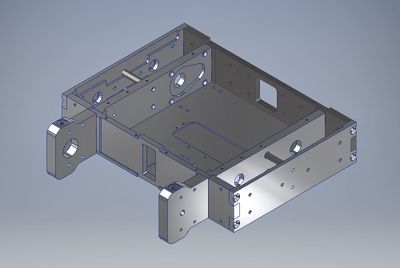Mandiv Design Guide
Introduction
Welcome to the Mandiv Design Guide! Mandiv is the fourth iteration of a 120 pound drum spinner created by RoboJackets. The purpose of this guide is to explain all of the reasoning behind the design decisions during the creation of Mandiv. This guide will go in depth on why certain designs were chosen as well as explaining some of the calculations used to support those decisions.
Design Basics
Chassis
Overview
The chassis of Mandiv consists of eight parts: the left and right inner side plates, left and right outer side plates, front plate, back plate, top plate, and bottom plate. These eight plates are the frame of the robot and are what hold the entire robot together.
Design Decisions
We designed the different pieces of the chassis to puzzle fit together. This was because puzzle fitting allows for stronger connections between plates as well as providing easier assembly due to each plate being able to fit in place without screws being needed to hold it there. Screws were then used to attach each plate to one another, ensuring the whole chassis remains intact.
Each plate was pocketed in certain areas in order to reduce the overall weight of the chassis, to allow for some other parts to be inset in the chassis, and to provide some extra clearance between the chassis and other parts of the robot.
Differences from Mandiii
The main differences between Mandiv's chassis and Mandiii's chassis are the overall length and width of the robot, the thicknesses of the front and back plates, a standoff is used to support the middle of the outer side plate instead of an aluminum plate, and the pocketing of the outer side plates.
The overall length and width of Mandiv was design to be shorter than that of Mandiii in order to reduce the overall profile of the robot.
The thicknesses of the front and back plates were increased so that a larger screw could be used to attach the outer side plates.
We decided to use a standoff instead of an aluminum plate because the plate effectively acted like a standoff and using a standoff reduced overall machining time.
The pocketing on the outer side plates was changed due reduce the risk of those plates bending, which was a problem at competition for Mandiii.
Notes/Helpful Advice
The water jet's tolerancing isn't perfect, so when designing puzzle fits, add a tolerance of around 0.007 inches to both sides in order to ensure that the pieces fit together easily. This will save a good amount of time because you won't need to file the pieces to make them fit together.
